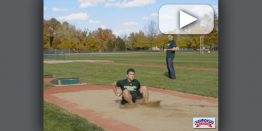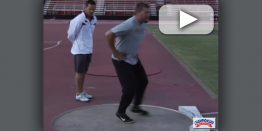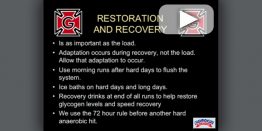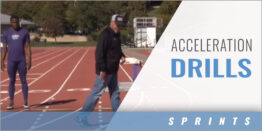Watch as Coach Travis Geopfert explains and demonstrates the three most common javelin grips.
Long Jump Incline Box Take Off Drills – Tim Cawley
Watch as Coach Tim Cawley explains and jumpers demonstrate these Long Jump Incline Box Take Off Drills.
High Jump Flexibility Drills – Sheldon Blockburger
Watch as Coach Sheldon Blockburger explains and a athletes demonstrates these Flexibility Drills using a cable.
Breathing Rhythms
The total amount of air that you breathe each minute is the product of the size and number of breaths you take each minute. As you start to run you usually increase both the size and number of breaths, but the rate at which you breathe is…
High Jumpers – Dynamic Stretch – Karen Gaita – East Stroudsburg Univ.
Watch as Coach Karen Gaita explains and athletes demonstrate these Dynamic Stretches for High Jumpers.
Hurdle Acceleration Drills – Elisha Brewer – Univ. of Kansas
Watch as Coach Elisha Brewer explains and a hurdler demonstrates these Hurdle Acceleration Drills
Acceleration Mechanics, Drills, Synthesis
Postural issues dominate the mechanics of track and field. Conserving posture throughout a race or trial in a field event is a key to optimal performance in any event. Initial postural issues from the start will be carried throughout the extent…
Shot Put Rotational Drills – Travis Geopfert – Univ. of AR
Coach Travis Geopfert explains and athletes demonstrate these Shot Put Rotational Drills
Flexibility for Cross Country From the Ground Up
Cross country athletes and runners in general typically have two goals: run faster and avoid injuries. Achieving both requires balance—between conditioning and recovery, joint stability and mobility, and the left and right sides of the body…
Pole Vault Approach Drills Using Mini Hurdles – Jeff Martin – IN ST. Univ.
Coach Jeff Martin explains and vaulters demonstrate these Mini Hurdles Approach Drills
Hurdles Wall Flexibility Drills – Karim Abdel Wahab – CO ST. Univ.
Coach Karim Abdel Wahab explains and hurdlers demonstrate these Wall Flexibility Drills
Breath Based Training – A Different Approach to Distance Training
For the past eight years, our cross country teams at Grove City College, an NCAA DIII school in western Pennsylvania, which competes in the Presidents’ Athletic Conference, have been using breathing-based training. My background in athletic…
Discus R.V.M. Drill – John Ridgeway and Greg Pilling
Coach John Ridgeway explains and Greg Pilling demonstrates the Discus R.V.M. Drill
Horizontal Jumps – Box Drills – Cliff Rovelto – KS ST. Univ.
Coach Cliff Rovelto explains and an athlete demonstrates these Horizontal Jumps – Box Drills
Training With Data
In High School, College, and at the Professional Level: Insights into how mid to long distance coaches perceive and use data to drive performance and progress.
100m Race Strategy with Dana Boone – Texas State Univ.
Coach Dana Boone discusses 100m Race Strategy
Common Ground – Technical Commonalities in the Jumps
Developing Horizontal Force. The approach should provide the jumper with horizontal momentum and velocity. This assists performances in events with great horizontal components. This horizontal velocity also eccentrically loads of the muscles of…
Discobolus
Old may not be quite the right word in the above title. Ancient may be the better word to describe twist in the context of this article. The most accurate Roman copy of the Greek original, Myron’s Discobolus circa 450-460 BC, “…is today…
High Jump Landing Drill – John Gartland – IN State Univ.
Coach Gartland explains and High Jumpers demonstrate this Landing Drill
Hurdle Landing Drills – Doug Case – Univ. of AR
Coach Doug Case explains and Hurdlers demonstrate these Landing Drills
Restoration and Recovery – Will Freeman
Coach Will Freeman discusses the importance of Restoration and Recovery
Acceleration Drills with Cliff Rovelto – Kansas State Univ.
Coach Cliff Rovelto discusses Acceleration Drills
800-1500M 8 Lane Tempo Run – Rose Monday
Coach Rose Monday discusses this 8 Lane Tempo Run
Hurdles Form Training Drills – Karim Abdel Wahab – CO State Univ.
Coach Karim Abdel Wahab explains and players demonstrate these Hurdles Form Training Drills
Track Exercises that Build Explosive Muscle
If you are a sprinter, jumper or thrower, you need to be explosive. Without this essential attribute, you will be left standing on the blocks, miss your jump height or fail to match your opponents on your throws.
The key to getting more…
Ties that Bind
After over twenty years as an athlete and coach in the sports of cross country and track & field reflecting on my experiences, both positive and negative, has helped me understand what it is I do and where my greatest successes have been…
Warm Ups for Sprints and Hurdles with Cliff Rovelto – Kansas State Univ.
Coach Cliff Rovelto discusses warm ups for sprints and hurdles
High Jump Takeoff – Short Approach Drill – John Gartland – IN State Univ.
Coach John Gartland explains and high jumpers perform this Short Approach Drill
Women’s Track Workout: Increasing Speed in the Weight Room
Over the course of my career, I have had opportunities to work with some very talented female track athletes, including NCAA Championship Qualifier and Academic All-American Jenna Caffrey (Iowa State). One overarching theme I’ve seen: no elite…
Ground-based Exercises to Aid with Acceleration
Acceleration is a force characterized by pushing. To accelerate forward an athlete must impart a backward force, a push, into the ground. The stronger the force is applied (with optimal technique), the faster the athlete accelerates. Force should…































